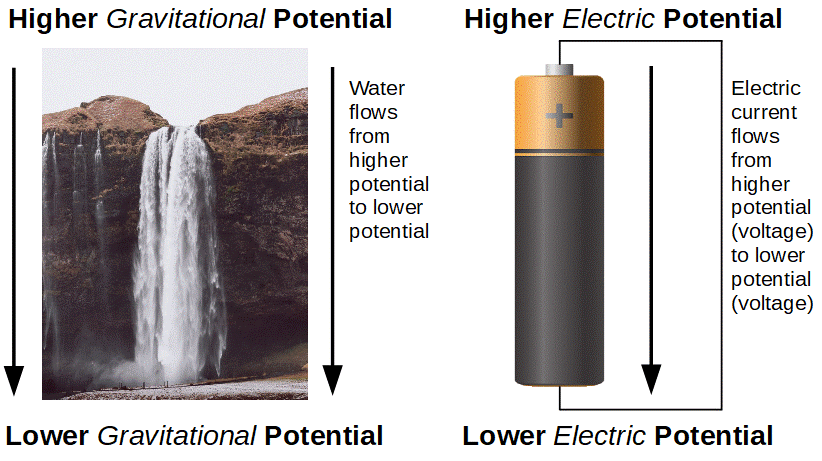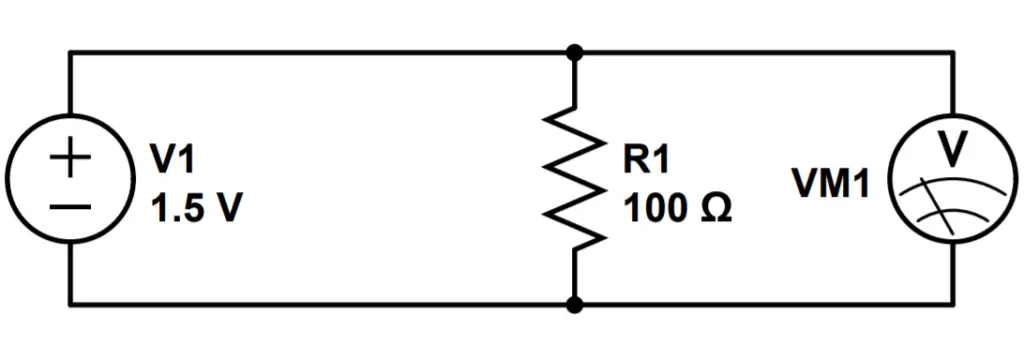Voltage
Voltage is the difference in electric potential between two points. Voltage provides the energy to electrons that results in electric current. a key component to any circuit.
Gravity provides a great analogy for voltage. A high point has more gravitational potential, and a lower point has less gravitational potential. An object falls from a point of higher gravitational potential to a point of lower gravitational potential.
This is similar to the way electric current flows from a point of higher electric potential (higher voltage) to a point of lower electric potential (lower voltage).
Without voltage, electrons would not flow through circuits and they wouldn’t be very useful. All of our electric devices and appliances would be weird paperweights. Voltage is the reason that we can harness and use electricity.

Voltage is measured in the SI unit of the volt. One volt equals one joule of energy per coulomb of charge:
1\hspace{1mm} Volt = \frac{1\hspace{1mm}Joule}{1\hspace{1mm} Coulomb}The best way to think about voltage is therefore in terms of energy per unit of charge. The higher the voltage, the more energy each unit of charge dissipates as it travels through the circuit.
What is Voltage?
Voltage is the difference in electric potential between two points.
You can think of this as a parallel to gravitational potential energy; the higher something is, the more potential energy it has because it takes work to lift an object. Conversely, that energy can be used or changed into another type of energy by reducing its’ potential energy, i.e. bringing the object to a lower gravitational potential.
Voltage and Ground
Voltage is always a comparison between two points. When we say that the ‘voltage is [x number of] volts’, we are usually comparing the electric potential at one point of the circuit to the negative terminal of the circuit, or to the ‘return path’, or to ground.
Ground is the reference point against which voltage is most commonly measured. Think of ground as similar to the way we talk about height; we say a ladder is 5 feet high, rather than referencing the center or the earth (or even ‘ground level’). No matter where the ladder goes, it is a 5 foot ladder because we always compare it the ground in that area. Similarly, electric ground in any circuit is the standard potential against which we measure every other point.
Ground is a relative value in the same way that the height of a five foot ladder is relative to the height of what the ladder stands on. The ladder could be used outside of a home that is on a mountain, in an area that is above sea level. The ‘absolute height’ is tough to quantify; should it be measured compared to sea level, the height of a local valley, or perhaps the center of the earth?
In the same way, the term ground doesn’t always refer to the same exact electric potential. Ground in one circuit could be different from ground in another circuit. However within a single circuit, this doesn’t matter much because a consistent ground will be used for that circuit. It’s like always measuring the height of something compared with sea level (ground being the sea level height in this analogy).
Gravity as Analogy for Voltage
Gravity works because matter has a property called mass, and all objects with mass are attracted to other objects with mass. The bigger the mass of the object, the stronger its’ gravitational pull.
We are attracted to the earth because of the earth’s great mass. The earth is attracted to the sun because of the sun’s great mass.
If we climb a mountain, we increase our gravitational potential. We now have more potential energy because of the difference in gravitational potential between the top and bottom of the mountain. If we throw a rock down to the bottom, it will convert all of that potential energy into kinetic energy by falling down.
Similarly, water always flows downhill, from a point of higher gravitational potential to a point of lower gravitational potential.
A waterfall provides a beautiful example of this.
Electric current also flows from a point of higher to lower potential, but in this case it is electric potential rather than gravitational potential.
When the two terminals of a battery are connected by a wire, current will flow from the positive terminal to the negative terminal because the positive terminal has a higher electric potential. This potential is described by the voltage rating of the battery.

What is the SI Unit for Voltage?
The SI Unit for voltage is the volt, which is abbreviated with the uppercase letter ‘V’. Voltage is also conveniently expressed by the letter ‘V’ in mathematical formulas.
Voltage is defined in terms of potential energy per unit of charge, or Joules (the SI unit for energy) per Coulomb. Mathematically, we could write this in the following ways:
Volts = Potential Energy / Charge = Joules / Coulomb = J / C = V
In other words, a voltage of one volt (1V) will impart one joule of energy for each coulomb of electric charge (6.24 x 1018 electrons).
Measuring Voltage with a Multimeter
Voltage is typically measured using a voltmeter, and is placed in parallel with the points on the circuit being measured. Most of the time voltage is measured between the point and ground/the negative terminal (rather than between two different points of interest). Multimeters are devices that allow the user to measure multiple functions commonly including voltage, current, and resistance.

Measuring Voltage with a Multimeter:

- Start with the meter in the ‘off’ position. Make sure that your measurement value will fall under the maximum rated voltage of the multimeter.
- Multimeters come with two test leads (probes), one (1) red and one (1) black probe. Connect each one to the multimeter. Connect the plug of the black probe into the ‘COM’ or common socket on the multimeter. Connect the plug of the red probe into the red ‘V’ or ‘INPUT’ socket on the mutimeter.
- Set the meter to the highest expected value of Voltage. If there is only one ‘V’ (voltage) option available, select it.
- Connect the black probe with the negative terminal of the voltage supply (i.e. battery) or a pre-established ground point. You can use alligator clips on the probe or hold it in place manually.
- Connect the red probe with the higher voltage point that you are interested in.
- Adjust the range selection on the multimeter to obtain the best reading. Be careful because selecting a range that is too low can damage the multimeter.
- Note the reading.
- Record the voltage at other points of interest by moving the red multimeter probe to those points.
- Turn off the multimeter and remove the red probe, then the black probe.
Where Does Voltage Come From?
AC Generators
Voltage is most commonly produced using AC generators such as those in power plants. In this case, voltage is supplied by a utility company through the power grid (mains power). When you plug a device into a wall socket, the voltage supplied by the power company causes an electric current to flow through your device.
Batteries
Batteries are one of the most common sources of voltage. There is a potential difference between the positive and negative terminals of the battery that is specified by the battery rating. For instance, a 12 volt battery has a 12 volt potential difference between its’ positive and negative terminals. The job of a battery is to supply the rated voltage for as long as possible. When the positive and negative terminals are connected to a closed circuit, the voltage supplied by the battery causes electric current to flow.
Solar Cells
Voltage can also be generated by the photovoltaic (PV) cells used in solar power systems. PV cells use sunlight to generate a voltage that can be used to store electric charge in batteries or capacitors. The electricity generated by PC cells can also be converted into AC power so that it can be connected to the power grid.
In each of these cases, a difference in potential energy is created and then exploited in order to create a force on electrons in a circuit. That force causes the electrons to move, which is known as electric current.
Voltage and Current
Voltage is the electrical potential difference that drives current (i.e. the movement of electrons) in a closed circuit. It stands to reason that increasing the voltage will result in a higher current.
However, it turns out that what the electricity is conducting through determines how much the current will increase when the voltage is increased.
Even high quality, highly conductive metals are not perfect at conducting electricity; there is always a little resistance that reduces the current a bit. The ratio of the voltage to the current is the electrical resistance, and the entire equation is known as Ohm’s Law:
\frac{Voltage}{Current} = ResistanceUnless we’re dealing with long distance power transmission, we don’t have to worry about the resistance of wires. However most circuits use resistors to control the current as well as the voltage. There is a circuit called a voltage divider that uses resistors in series to produce little ‘taps’ with different voltage levels.
High Voltage: Lightning and Spark Plugs
If the voltage between two points is high enough, current can flow even if the points are not connected by electric conductors. This is called dielectric breakdown. A spark is an example in which voltage is high enough that the air between two points becomes ionized. As the electrons travel through the air, they collide with the air molecules causing them to fluoresce, simultaneously emitting light, heat, and sound. For a spark to form, the voltage must generally be at least 30kV (30,000 V) per mm of gap between the two points being sparked across. This voltage is called the dielectric strength of the air. Check out our comprehensive table for the dielectric strength of many common materials here.
Lightning is a great example of a natural spark, and a single lightning bolt will often strike at about 1 BILLION volts!
Spark plugs are another common example of the usage of high voltage in an interesting application. Spark plugs use a high voltage in order to create a spark that is used to ignite fuel in a combustion engine. The voltage in a spark plug is typically at least 25,000 V although 40,000 to 100,000V is more common.
In each of these examples, we can see that that it is the presence of voltage that creates the electric current. Note that voltage does not ‘create’ the electrons themselves; it simply causes the electrons between the points to move.
Voltage and Electromotive Force (EMF)
While voltage is a common term, you may also here the term electromotive force, or EMF, being used to describe a difference in electric potential.
Despite its’ name, EMF is not a force, it is a type of voltage. EMF and voltage have identical units, and the difference between the two terms is a bit subtle. EMF is measured in volts, which can make it tough to understand.
EMF describes a voltage produced by a non-electrical source, like a battery or generator. For example, a battery converts energy from a chemical reaction into a voltage, and a generator converts mechanical energy into a voltage.
Within a circuit, EMF can be understood as a ‘counter’ to voltage. In a circuit, EMF described the energy given to each electron by the battery or generator. Voltage describes the energy ‘used’ by the electron as it flows through the circuit. EMF tells us how much energy is produced inside the battery or generator (per unit charge), and voltage tells us how much energy is consumed when charge travels through a circuit (per unit charge).
For example, the label of a 1.5 volt battery tells us that the EMF produced by the battery is 1.5 joules of energy per 1 coulomb of charge (6.24 x 1018 electrons). If we then connect the two terminals of the battery through a resistor, the resistor is forced to ‘drop’ 1.5 volts across it, because that’s the battery voltage. The voltage across the resistor is 1.5 volts. As we can see, the EMF and voltage both describe the same amount of energy per electron; the EMF is the energy produced by the battery and the voltage is the energy dissipated by the resistor. They are equal; both are 1.5 volts.
To understand voltage in greater detail, we will need to tackle the subject of electrical resistance.
Let’s learn more in Lesson 5: Electrical Resistance.